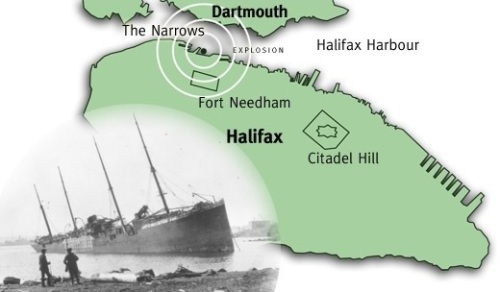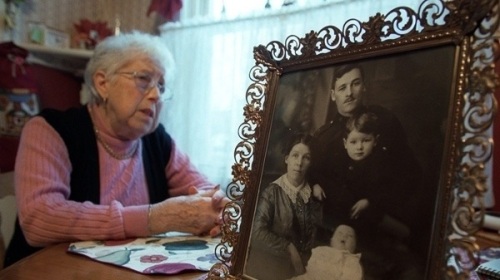My apologies, this was meant to be published yesterday but I was sidelined by a migraine.

An annual remembrance ceremony is held at the Halifax Explosion Memorial Bell Tower on December 6, with a short silence just before 9:05 a.m., the time of the explosion.
The 6th of December has been a day of remembrance here in Halifax since 1917. That was the day the French cargo ship, the SS Mont-Blanc, collided with the Norwegian SS Imo in the Narrows of the Halifax Harbour. The Mont-Blanc was fully loaded with wartime explosives and the collision caused a fire on board ignited her cargo and caused a cataclysmic explosion that devastated the city.
The Halifax Explosion was the largest man-made explosion prior to the atomic bomb being dropped on Hiroshima, with an equivalent force of roughly 2.9 kilotons of TNT.
How this disaster happened is quite the story of circumstance and bad luck, and is definitely worth a Google. It basically boils down to the dangerous cargo laden Mont Blanc being allowed in the harbour due to the threat of nearby German U-boats, and the stubborn Captain of the Imo refusing to give the proper right of way.
After the collision, a spectacular fire erupted on the Mont Blanc and people gathered on the streets and along the waterfront to watch, ignorant of what was in her hold. Twenty minutes later, when the ship exploded, over 1,600 people were killed instantly. White-hot iron rained over the city with a barrel of one of Mont-Blanc’s guns landing approximately 5.6km (3.5mi) north of the explosion. This part of her anchor, which weighs 520kg (1140lbs), landed 3.2km (2mi) south.
The harbour floor was momentarily exposed by the blast and the result was a tsunami, which rose almost 20 m (65 ft) over the usual high water mark obliterating areas of the shoreline, including enclaves of Mi’kmaq First Nation peoples that dated back to the 18th century.
1,630 homes were destroyed in the explosion and fires, with 12,000 more houses damaged. Roughly 6,000 people were left homeless and 25,000 without adequate housing.
This is a picture of the worst hit area of the city before the explosion.
This is after.
To make matters worse, it got really cold and Halifax had its largest blizzard in a decade the next day, blanketing the city with 41cm (16in) of heavy snow. Those that were trapped in blown out houses died of exposure.

Approximately 2,000 people were killed by debris, fires, and collapsed buildings, and it is estimated that an additional 9,000 others were injured, 6,000 of them seriously. The population of Halifax was only 60,000 at this time. The same percentage of today’s population would equal 14,000 deaths and 60,000 injuries.
Of course, as a school child learning this history, the stories and images of the children were the ones that stuck with me.
Classes started at 9:30 at Richmond School so only two children died in the building, but eighty-six other students died at home or on their way to class.
“Ashpan Annie” was 23 months old. Her brother and mother were killed in the blast, which leveled most of their house. Annie was blown under the kitchen stove, where the warm ashes in the ashpan kept her alive in the frigid weather. She was rescued 26 hours later by a neighbour who was looking for his own family. Her father was a soldier who was overseas at the time.
She was taken to the hospital where she was discovered by her grandmother and aunt. Annie Welsh continued to live in the same area of Halifax until she died in 2010, at the age of 94.
Of course, as children we loved the heroic tales. Anyone of my generation who grew up watching Canadian TV will remember the Heritage Minute about train dispatcher Vince Coleman.
We also learned about the tremendous amount of aid our city received. For example, as soon as Boston authorities learned of the disaster they organized and dispatched a relief train full of food, water, and medical supplies. Also on the train were volunteer medical and emergency workers. Of course Nova Scotia received aid from across Canada and many other countries, but these volunteers from Massachusetts was the first to arrive and also the last to leave.
It is now a Christmas tradition for Nova Scotia to ship one of its biggest and best Christmas trees to Boston as a symbol of thanks. Each year, the tree is selected from a private landowner and it’s considered a great honour to have your tree chosen. This tree becomes Boston’s official Christmas tree, alit in the centre of the Boston Common.
Haligonians are able to look back and see the legacy that the explosion has left behind. Social assistance programs and emergency protocols were established. New housing developments were quickly built and neighbourhoods reestablished. The Hydrostone area was built and it continues to be highly prized real estate.
The train station was rebuilt next to newly erected seawall Piers. Pier 21 is now famous for the part it played as an international gateway for the thousands of immigrants and war brides who walked through its doors from late WW1 to the 1960’s.
The medical team on the first train from Boston was under the supervision of a young surgeon named William Edwards Ladd. Ladd treated thousands of individuals injured in the explosion; including hundreds of children who had suffered burns and lacerations as a result of watching the explosion with their faces pressed against windows. He was profoundly changed by the experience and devoted the rest of his medical career in Boston entirely to the surgical care of infants and children. He is known as “the father of pediatric surgery”.
Because so many people watched the initial fire through windows, over 600 people suffered eye injuries in the explosion, and 38 of those lost their sight. This led to significant advances in eye care and Halifax became internationally known as a centre for care for the blind. Medical knowledge that was directly learned in the aftermath of the explosion continues to be taught at Dalhousie and Harvard medical schools today.
On December 6th, I always take time to remember the Halifax Explosion, but I choose to remember it as a story of reconstruction, compassion, and determination. The people of Halifax literally rose out of the ashes and rebuilt the city and their lives.
If you’re not from Canada, had you heard of the Halifax Explosion before?
















I have. It was the catalyst event in a novel I read some 3 or 4 years ago now I think. I hadn’t heard of it before, and I thought it was an imagined event, but I googled it to check and was amazed. If I ever get to Halifax I will check out the memorial.
Because it was such an important part of our history I’m always happy to hear people have heard about it. Thanks for letting me know. 🙂
I heard of the Halifax Explosion many years ago and read three books about it. In the summer of ’12 my wife and I visited Halifax and got to see the place where it happened. It was tragic but there were so many heroes. I hope it never is forgotten. Halifax is a beautiul city. S. Irving Granderson, Rogers Arkansas, USA
Glad to hear our history made an impact! Thanks for such a great comment and especially thanks for reading.
Pingback: Remembering the 6th of December – Montreal Massacre | Escaping Elegance